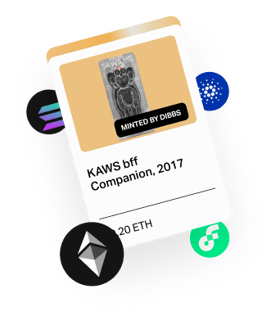Redeemable NFTs vs. Claimable NFTs: What’s the Difference?

Explore the differences between claimable and redeemable NFTs and how they can revolutionize brand engagement and user loyalty
Navigating the world of NFTs often means encountering a plethora of jargons and terminologies. Among these terms, businesses and customers are often presented with the concept of redeemable and claimable NFTs.
Though they might seem similar at first glance, each has its unique characteristics and grasping the nuances of both types of NFTs can help brands understand their benefits and make informed decisions.
So, in this article we define what redeemable and claimable NFTs are, list out their differences, and outline their benefits.
Subscribe to get our best content in your inbox
By clicking “Submit” you agree to Dibbs
Privacy Policy and
consent to Dibbs using your contact data for newsletter purposes.

What are Redeemable NFTs?
Redeemable NFTs allow the holder to claim an associated item or service. They’re beneficial for brands that want to engage and retain customers as it allows them personalize rewards and create a sense of exclusivity. There are two different kinds of redeemable NFTs:
- One that’s burnt (meaning, it can no longer be purchased, transferred or sold) when the redemption process is complete.
- Another that allows holders to redeem their NFTs partially for more items or experiences. These are multi-redeemable NFTs and the metadata may be updated to reflect the change in redemption status and the number of times it can be further redeemed.
The Rebirth NFT collection consisting of 4,000 NFTs backed by whiskey bottles is a great example of redeemable NFTs.
What are Claimable NFTs?
Claimable NFTs refer to non-fungible tokens that users can "claim" or acquire, often for free or as a reward, from a specific platform or project. These NFTs are not immediately transferred to the user's wallet but are set aside for them to claim when they choose to, often through a designated claiming process.
They’re commonly used to incentivize users to support a project and are distributed on a first-come, first-served basis for a limited time. For example, Amazon gave away free gaming NFTs to prompt users to check out their new gaming portal.
Claimable NFTs can also be used to reward members for their participation. In such cases, brands may reward users based on the tasks they’ve completed.
The Difference Between Redeemable and Claimable NFTs
Let’s look at a few other differences between redeemable and claimable NFTs to understand the distinction better.
Acquisition Process
Unlike traditional NFTs that are directly transferred to a user's digital wallet upon creation or purchase, claimable NFTs remain in a reserved state within the issuing platform. The intended recipient should actively work towards claiming the NFT; they must fulfil a few conditions or go to a website and sign a transaction to claim the NFT.
Redeemable NFTs, on the other hand, operate a bit differently. They can be acquired through a purchase or a gift, much like traditional NFTs or even claimed like claimable NFTs.
Value Realization
The act of claiming an NFT doesn't inherently bestow immediate tangible value to the claimant and is simply a process of acquiring digital ownership. Its true value remains latent until the owner decides to interact with it further, sell it, or use it in some other capacity.
For example, if a user receives a rare NFT as reward for completing a few tasks on the platform, they can’t obtain value from it unless they use it to unlock specific benefits or resell it on a secondary marketplace.
The act of redeeming an NFT, on the other hand, directly translates to tangible value or utility. When someone redeems such an NFT, they're exchanging it for something of discernible worth.
This could be a physical object, like a piece of art or merchandise; a digital asset, such as exclusive online content or software; or even experiential value, like access to a private event or a unique online experience.
Utility
Once a user obtains a claimable NFT, it doesn’t become redundant. Depending on its nature, it might serve as a collectible or grant access to online communities. Over time, the NFT’s value may also appreciate based on its rarity, the reputation of its creator or its significance within the community. As such, claimable NFTs can be seen as a form of investment.
However, when the primary function of a redeemable NFT is fulfilling the promise of a physical or digital item. Once this is complete, in most cases, the NFT is burnt and only the physical item can be transferred or resold.
In essence, claimable NFTs are about acquiring a digital asset and redeemable NFTs are about exchanging the digital asset for an item or experience. That means a claimable NFT can also be a redeemable NFT.
Let’s say a music artist decides to reward their most loyal fans with an exclusive digital album and tickets to their concert. The artist could issue claimable NFTs to specific addresses. And once the fan claims the NFT, they can exchange it for the album or the tickets. This can be beneficial for brands in many ways.
Benefits of Creating Claimable and Redeemable NFTs
A claimable and redeemable NFT offers a multifaceted approach to user engagement, combining the allure of exclusive digital assets with the tangible benefits of redeemable goods or services.
By making the NFT claimable, projects can ensure that specific users or addresses (e.g., early supporters, loyal customers) are the ones receiving the NFTs, allowing for targeted rewards or promotions. This creates an interactive experience and fosters a deeper connection between the project and its community.
The redeemable aspect offers a clear value to the holder, as they can exchange the NFT for real-world or digital goods and services. All in all, both aspects enhance user loyalty and drive sustained engagement.
Create Claimable and Redeemable NFTs with Dibbs
Claimable and redeemable NFTs enhance brand visibility and create a sense of exclusivity for customers, which deepens their connection with the brand. However, the journey of implementing these NFTs isn’t without its challenges. Brands have to create a simplified NFT claim process and deal with privacy and logistics concerns when it comes to redeeming NFTs.
This is where Dibbs comes into play. As a premier tokenization platform, Dibbs effortlessly transforms your brand's items into digital collectibles. We also help you create a simplified claim experience and guide customers through the redemption process.
As for logistics, securely store items associated with NFTs in state-of-the-art vaults, ensuring safe delivery upon redemption. This not only enhances the customer experience but also eliminates the need for brands to engage with third-party storage providers. To learn more about how Dibbs can tokenize physical items and boost your revenue, schedule a demo today.

Jonathan Barbone
Jonathan Barbone is the Senior Director of Partnerships at Dibbs. Jonathan was an avid Magic: The Gathering card collector as a child.

